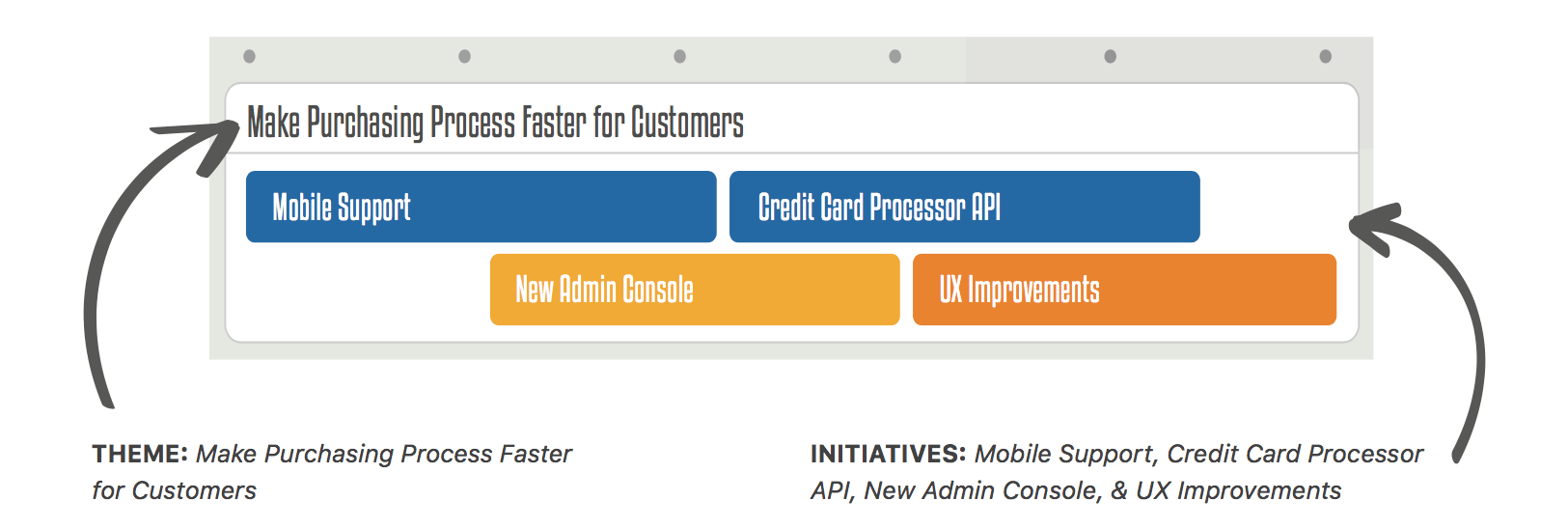Are you prepared for your next product roadmap presentation? How are you planning to run better product roadmap presentations? As product managers, the product roadmap is at the core of everything we do. It is a living document that sheds light on what’s happening today, tomorrow, and in the future. The product roadmap is a key point of reference to keep product strategy, business objectives, and execution aligned. When properly shared and evangelized across an organization, a product roadmap can unite, motivate, and align cross-departmental teams to achieve more. And the first step to evangelizing your product roadmap across your organization is getting it out there for all to see.
Read the Product Roadmaps Guide ➜
Today we look at a few simple tips for product roadmap presentations. We hope these will help ensure your next product roadmap presentation is well received by other internal teams.
5 Hacks for Better Product Roadmap Presentations
1. Tell a story
We’ve written before about the importance of storytelling in product management, so it should be no surprise that this topic is coming up again. An interesting story or anecdote can add valuable context to your presentation that your roadmap simply can’t do on its own.
You don’t need to write an elaborate piece of fiction to be a good product storyteller. In fact, the most powerful narratives are not fiction at all. Simply tell the honest story of how your roadmap came together. Was there a customer request that inspired a new feature? Are you adding some features and functionalities that help push you closer to the product’s vision? Were there any particularly difficult prioritization decisions you can share? Whatever your story is, use it as a tool to keep your audience engaged and to rally their support around the plan.
2. Focus on themes, not features
Grouping initiatives on your roadmap into thematic buckets is not only a great tool for prioritization but also an excellent communication aid. Theme-based roadmaps are one of the best ways to give your product roadmap a memorable and meaningful narrative because themes highlight the big picture. Rather than sharing a laundry list of initiatives product is focused on, themes show the broader objectives at play and make it easier for you to sell your product strategy.
Here is a graphic to help convey the difference between a theme and an initiative. Notice the goal-driven nature of the theme and the task-based language of the initiatives.

Download Feature-less Roadmaps: Unlock Your Product’s Strategic Potential ➜
3. Use visual aids
It should go without saying that a product roadmap presentation requires you to actually show people a visual representation of your roadmap. People need to see how all the various components of your product strategy fit together, so invest time in making sure your product roadmap is well-designed. There are several best practices for designing visual roadmaps, but here are a few guidelines we think are most useful:
- Use color to distinguish between different themes, objectives, or categories on your roadmap. Don’t forget to include a legend outlining what each color signifies.
- More than half of roadmap owners we surveyed in our 2021Product Planning Report told us they make different versions of their roadmaps for different audiences. One version of the roadmap is not always sufficient to convey both the big picture and a more granular view of what’s involved. Consider creating two (or more!) different views of your roadmap to better communicate your strategy.
- Don’t overwhelm your audience with too many details. Your visual product roadmap should contain only the most relevant information. When in doubt, take it out.
4. Know your audience
Channel your inner marketer and tailor each presentation you do to the interests of the audience involved. Executives care about different aspects of product strategy than sales, and sales likely hold different interests than engineering. Furthermore, these groups have varying degrees of understanding around the inner workings of the product and therefore different ways of relating to you as the product manager.
Focus your roadmap presentations around sharing the most relevant information with your audience. If you’re presenting your roadmap at an all-hands meeting or to a broader audience, speak broadly about it. Don’t attempt to delve into a detailed explanation of each and every feature on your roadmap unless that’s what your audience wants. Instead, focus on showing how your product strategy supports organizational objectives and aligns with your product’s vision.
5. Tie in metrics
If you’re having a difficult time rallying the team around your plan, remember that metrics are the great arbitrator; they force us to make objective decisions and not rely on intuition alone. They’re also an important part of the narrative around your product roadmap. You likely used metrics to make your roadmap decisions in the first place, so put them back to work for you when presenting your product strategy.
If your organization is closely monitoring a handful of key business metrics, or has a “north star metric,” put these numbers front and center in your presentation. If it’s not immediately clear on your visual roadmap how initiatives influence key metrics, take time to walk through this in detail. Don’t underestimate the power of numbers. They are a powerful tool for selling your product strategy and getting buy-in across your organization…after all, you can’t argue with data.
Bonus Tips for Better Product Roadmap Presentations: Keep it going
1. Make it an ongoing conversation
Sharing your product roadmap is only a small part of the communication that needs to be done around product strategy to evangelize your mission. Avoid thinking about communication as an event and instead bake it into your culture and product strategy. After all, the product roadmap is a living document that evolves in response to the world around it. Your communication should reflect that. Transparency around product strategy at every step of the way ensures no one gets left in the dark.
2. Put your roadmap front and center
Once you’ve done a good job selling your product strategy, don’t hide it away. Keep an up-to-date copy of your product roadmap somewhere easily accessible by other teams who may want to reference it as they develop their own strategies. We’ve heard of a few teams who are so proud of the product roadmaps that they display them on large screens in their offices, but you don’t have to take things that far. A well-circulated and maintained internal document can suffice.
What strategies have you used to successfully share and evangelize your product roadmap across your organization? Let us know in the comments below!



